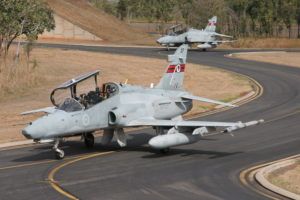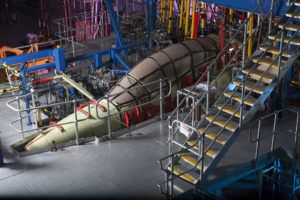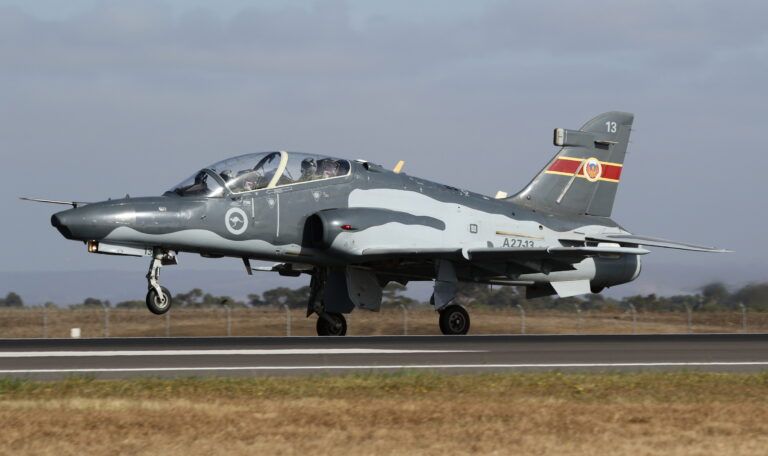Following fourteen years of continuous testing, Australia’s Defence Science and Technology Group and BAE Systems, in partnership with the Australian defence airworthiness authority recently concluded a full-scale fatigue test of the Hawk trainer jet.
The successful conclusion of the Full-Scale Fatigue Test (FSFT) program validates the Royal Australian Air Force’s (RAAF) fleet of BAE Systems Hawk Mk.127 aircraft for 50,000 flight hours, representing five full lifetimes. The test program began at the Defence Science and Technology Group’s (DST) facility at Fishermans Bend in Melbourne in February 2006 and was formally concluded on June 5, 2020.
The program subjected a structurally complete Hawk test airframe to the full range of loads potentially experienced by the operational fleet, based on the RAAF’s projected operational requirements. According to BAE Systems the 50,000 flight-hour validation is five times the current clearance of most of the modern Hawk trainers in service around the world, and around ten times greater than the current Australian fleet leader.
Australian requirements
The first of 33 RAAF Hawk Mk.127 trainers entered service in 2000. A structural test airframe was also part of the contract. The FSFT program was specified within the contract, to be delivered under a commercial agreement between BAE Systems, DST and what is today known as the Defence Aviation Safety Authority’s Directorate of Aviation (Specialist) Engineering – or DAVENG-DASA.
Although BAE Systems as the OEM had extensive fatigue test data for earlier variants of the successful Hawk family, the Australian Mk.127 would differ in several key areas – being 60cm (23.6in) longer and 20% heavier for example. These differences, combined with operational flight profiles unique to the RAAF at the time, led to the determination that a new full-scale fatigue test would be required.
To achieve this, AU$11.7 million was allocated within the acquisition budget for the FSFT program. To accommodate the FSFT and other important programs planned at Fishermans Bend, DST constructed the
H. A. Wills Structures and Materials Test Centre. The facility, named after an Australian pioneer of aircraft fatigue testing, was opened in August 2004.

“Technology transfer was a component of the contract for the supply of the Hawk Mk.127 and, having requested that a full-scale fatigue test be carried out, the placing of the test at DST Fishermans Bend was part of that technology transfer,” says BAE Systems.
“The original objective was to provide a clearance for the operational aircraft of 10,000 flying hours to the fatigue spectrum and masses detailed within the contract. To achieve this, it was necessary to test the airframe to an equivalent of 50,000 flying hours to ensure both the monitored and un-monitored structure was cleared and this objective hasn’t changed over time.”
Fatigue test overview
When the FSFT program began in February 2006 the Hawk Mk.127 structure had an interim clearance for 3,000 hours of operational use in RAAF service and although the ultimate goal was to validate the full 10,000-hour life, the immediate priority was to achieve test equivalence of the interim clearance before the operational fleet leader.
Under the FSFT partnership contract DST was responsible for conducting the testing program at Fishermans Bend on behalf of BAE Systems. As the prime contractor to the Commonwealth of Australia, BAE Systems was responsible for the design of the test rig and test loading and spectrum development. As the sole conduit of test-related data back to the Commonwealth, the company was also tasked with the review of all inspection and test information arising from the program and for the development of any further actions.
BAE Systems was also responsible for the analysis and read across of issues coming from the testing and the development of any subsequent recommendations for the operational RAAF Hawk fleet. Further work included the design of test article repairs, provision of test clearance data and the co-chairing of Joint Technical Review Meetings (JTRM) with the Commonwealth, represented by DAVENG-DASA.
While DST was responsible for the day-to-day running of the test program at Fishermans Bend, it was also charged with the completion of both scheduled and unscheduled inspections of the test article as directed by the OEM. Other responsibilities included the recording of all data from the program and the performance of repairs required by BAE Systems.
Representing the Australian military airworthiness authority, DAVENG-DASA provided concurrence with critical test documentation and concurrence of test article and operational fleet actions and was co-chair of the JTRM with BAE Systems.
The structural test article was manufactured by BAE Systems at Brough, UK and was shipped to Australia in May 2003. The airframe was the 25th Hawk Mk.127 to be built and was factory-fitted with 326 strain gages before delivery, After its arrival at Fishermans Bend, DST installed a further 259 sensors. It was also fitted with a production-standard windscreen and canopy to allow the application of cockpit pressurization loads. As such, the test article is a structurally complete, production standard, Hawk Mk.127 fuselage, with the wings and fin.
Testing methodology

The test article was installed in a purpose-built test rig within the H. A. Wills facility, which is itself capable of maintaining a stable testing environment and adequate quantities of hydraulic oil and compressed air. A test control room within the facility houses a control system and afforded a clear view of the test itself.
Some aircraft structural items were cleared by alternative means and therefore not fitted to the test article, while others were dummy items, used to introduce loads without being subject to analysis in their own right. As is normal practice, any items regarded as non-structural were omitted from the test.
“The test specimen was mounted in the test rig such that it was supported just aft of the cockpit, reacting vertical and lateral loads; and via the dummy engine, reacting vertical, lateral and drag loads,” says BAE Systems. “Loading was applied to the specimen to represent all the aerodynamic and inertia loading for each balanced load case, but excluding the engine loads. By loading and supporting the airframe in this way it means that reaction loads at the dummy engine represent the missing engine loads, while the reaction loads aft of the cockpit should be zero.”
The loads were applied to the test article by 83 hydraulic jacks, each fitted with pressure relief valves to prevent overloading and a compressed air system was used to represent cockpit pressurization loads and simulate fuel tank pressures. All loading devices were controlled by an electronic control system, which simultaneously controlled the 90 items – comprising of the hydraulic jacks, six independent air pressure systems and one channel to control the operation of the flap control actuator.
Testing of the Hawk flap control system represented arguably the only unusual aspect of the test. Although the flaps themselves were dummies, the test article had a functional flap control system, capable of cycling through an operational airframe’s full 50° of movement.
“There were numerous safety features as an integral part of the control system, these protected the specimen from accidental overload. If the system detected any anomaly, such as a drop in pressure in a circuit, then it slowly removed the loads and stopped the test,” BAE Systems says. “The system had its own emergency power supply so that it remained capable of stopping the test in a controlled manner even in the event of a power cut.”
Simulation and modeling also played an important role in the test program, with the use of a full aircraft Finite Element Model to support development of test loads and the analysis of test arisings. In addition, solid FE Modelling was used to support analysis.
Outcomes and conclusions
While BAE Systems did not provide specific details of items arising from the FSFT or their potential impact on the operational Hawk Mk.127 fleet, the company nevertheless says that the test achieved the overall equivalent of 50,000 flying hours, providing the required fleet clearance for the RAAF and also the necessary clearances for the wider Hawk fleet.
“Generally, anything significant arising on the test that was likely to result in a fleet action was reviewed with the customer and other stakeholders at an annual JTRM,” BAE Systems says. “The meeting was co-chaired and reviewed the test progress and any significant arisings and their potential impact.”
Besides sharing the results with the RAAF, the OEM is using the data obtained from the 14-year test program to support the structural integrity clearance for all Hawk operators around the world.
Based on current usage, the FSFT program has determined that the Hawk Mk.127 has sufficient remaining fatigue life to allow the RAAF fleet to continue flying until well into the late 2040s.





